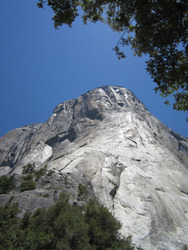What I Learned About Craft from Yosemite's Big Wall Climbing Legends
 I’ve had the great fortune to be invited along on a new creative project that is full of true and figurative adventure. I’m part of a small team working on a documentary film of legendary climbing gear designer, photographer, inventor and iconic Yosemite climber Tom Frost. Recently, our three-man film crew had the opportunity to attend the first annual Oakdale Climbers Festival. Here, we interviewed an incredible number of influential climbers from the last 50 years of Yosemite’s storied climbing legacy (including Doug Robinson, Glen Denny, Paul Piana, Steve Grossman, Peter Haan, Ken Yager and Hans Florine) and heard the stories of living legends (including Al Steck, Jerry Gallwas and the team of Tom Frost and Royal Robbins).
I’ve had the great fortune to be invited along on a new creative project that is full of true and figurative adventure. I’m part of a small team working on a documentary film of legendary climbing gear designer, photographer, inventor and iconic Yosemite climber Tom Frost. Recently, our three-man film crew had the opportunity to attend the first annual Oakdale Climbers Festival. Here, we interviewed an incredible number of influential climbers from the last 50 years of Yosemite’s storied climbing legacy (including Doug Robinson, Glen Denny, Paul Piana, Steve Grossman, Peter Haan, Ken Yager and Hans Florine) and heard the stories of living legends (including Al Steck, Jerry Gallwas and the team of Tom Frost and Royal Robbins).
As a writer, I’ve often turned to, read about and taught the words of other authors as they’ve related their ideas and experiences of writing as a craft, rather than as a deeply-ingrained talent that some elite few were somehow born with. After spending a long weekend with a group of eclectic, bearded souls with calloused hands and sinewy forearms, I realized that writers can learn a lot from those that have dedicated their lives to the craft of climbing.
Climbers see the ascents of sheer granite faces as problems to be solved, games to be played and emblems of a life to be lived in harmony with nature. Perseverance, and the ability to put aside fear and self-doubt are far more important than raw talent. Collectively and individually, they are the most self-sufficient, ascetic artists I’ve met. The Golden Age of Yosemite Climbers strove to adhere to the ideals of their mentor and inspiration, John Salathé, bringing a quart of water per man, per day, while vertically moving, inch-by-inch, on week-long climbs of grueling physical activity against sweltering granite cliffs. They were doing this using homemade equipment – thin metal wedges that had been hand-hammered and shaped on anvils in backyard forges – not only to ascend, but also for their own tenuous protection from fatal falls. It’s the writer’s equivalent of creating a novel on a hand-built typewriter that the self-same author had somehow kluged together from pen springs, hacksaw blades and handmade ink. Imagine using a font that had been manually shaped and pressed on small bits of scrap metal to the tip of each typewriter key, simultaneously crafting the work of art and the tools used to create it.
More on the documentary, and the birth of Flatlander Films soon.



